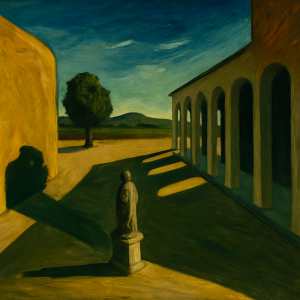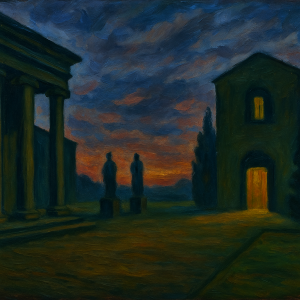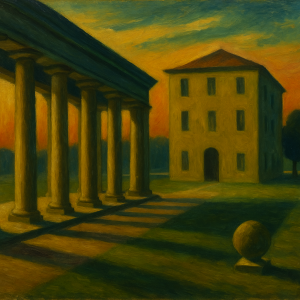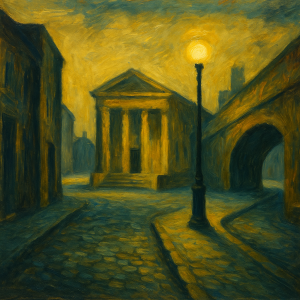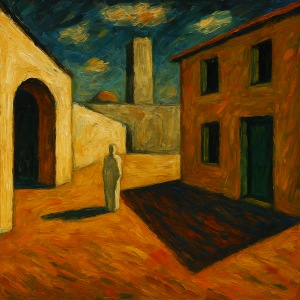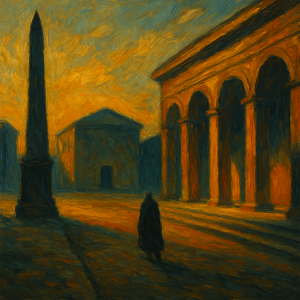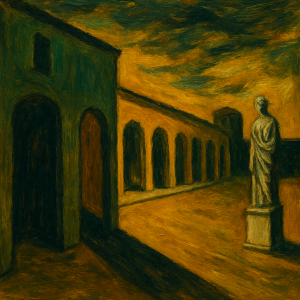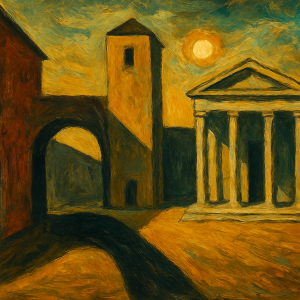A Retrospective of the Works of René DeChirico
Introduction to the Works of René DeChirico (1898–1967)
The collection of fifteen surrealist paintings gathered here represents not merely a body of work, but a vision that transcended the tumultuous first half of the twentieth century. René DeChirico (1898–1967), though often overshadowed by his more widely known contemporaries, carved for himself a path that was deeply individual, poetic, and, at times, profoundly misunderstood. Today, the very canvases that once puzzled critics hang as celebrated masterpieces, reclaimed from major metropolitan museums and private salons alike. This exhibition, assembled from collections across the globe—including the personal holdings of the King himself—presents a rare and unified glimpse into DeChirico’s extraordinary imagination.
Early Life and Struggles
Born in Florence in 1898 to a modest family of tradesmen, René DeChirico’s artistic inclinations were apparent from an early age. Sketches of city plazas, narrow alleys, and architectural forms dominated his boyhood notebooks. Though he studied briefly at the Academy of Fine Arts in Turin, DeChirico largely resisted the rigid academic style, preferring instead to pursue independent explorations of dreamlike landscapes and distorted urban spaces. His early attempts to break into the European art scene were met with difficulty, not least because of the artistic climate of the time, which privileged avant-garde abstraction over the haunting figuration he was beginning to cultivate.
His most disheartening professional setback came in 1923, when DeChirico submitted a portfolio of canvases for inclusion in the Paris Exhibition. The jury dismissed his work as derivative and “insufficiently modern,” a wound that weighed on him for years. That rejection, however, also solidified his determination to persist outside the approval of established circles. He took up a position teaching drawing in provincial schools, supporting himself and his growing family while painting in relative obscurity.
Marriage and Family
In 1925, René married Desdemona Toullous, a French émigré of Greek descent whose wit and elegance charmed the artist’s circle of friends. The marriage was a partnership in the truest sense: Desdemona’s financial acumen and encouragement gave DeChirico the stability to continue working through lean years. The couple had five children together. Of them, Davide DeChirico would later emerge as a painter in his own right, emigrating to California after the Second World War. From 1960 until his death in 1997, Davide carried forward his father’s atmospheric sensibilities, albeit in a distinctly Californian idiom of wide horizons and sharp sunlight.
Breakthrough in Belgium
The Second World War marked a turning point in DeChirico’s life and career. Displaced by the conflict, he resettled in Belgium in the late 1940s, a country whose art market was beginning to reawaken after years of devastation. There he encountered a cadre of collectors and critics who were newly receptive to his brand of brooding surrealism, with its plazas emptied of humanity, stark architectural facades, and mysterious plays of light and shadow. The Belgian critic Henri Dumont described DeChirico’s works as “portals into the subconscious, where memory, absence, and presence fuse.” This praise was the catalyst for his recognition. Exhibitions in Brussels and Antwerp in the early 1950s brought his paintings into the salons of prominent collectors, and within a decade his works had been purchased by museums in London, New York, and Milan.
Legacy and Influence
Though his reputation fluctuated throughout his career, René DeChirico is now recognized as a vital figure in twentieth-century surrealism. His canvases evoke a world both familiar and estranged: a plaza that might belong to any European city, yet emptied of sound; a train glimpsed in the far distance, moving toward or away from consciousness itself; a fountain shimmering in the heat of a deserted square. They are meditations on time, place, and the persistence of memory, painted with bold, expressive brushstrokes that linger as both architectural structure and emotional residue.
DeChirico died in 1967, leaving behind a large and varied oeuvre. His widow Desdemona preserved many of his works until her own passing, dispersing them slowly to private collectors across Europe and the Americas. Today, these paintings form a bridge between the fragmented memory of modernity and the unyielding dreamscapes of the subconscious.
The present exhibition unites fifteen of DeChirico’s finest surrealist works—many unseen in public for decades. To walk among them is to enter the liminal world that René DeChirico made his own: one where silence speaks, light bends memory, and architecture itself dreams.

